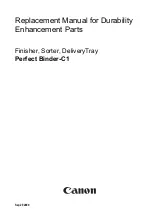
– 25 –
Adjustment procedures
Results of Improper adjustment
1) Replace the upper knife
1. Loosen the screw
❶
and move the lower knife holder
❷
to the
left. Then, tighten the screw
❶
a little.
2. Remove the screw
❸
and replace the upper knife
❺
with a new
one. Then, tighten the screw
❸
a little.
3. Turn the pulley to move the upper knife
❺
to the lower dead
point. Adjust the height of the upper knife
❺
so that the upper
knife
❺
can cross the lower knife
❻
about 0.5 to 1.0 mm. After
the adjustment, tighten the screw
❸
.
4. Loosen the screw
❶
and return the lower knife holder
❷
to its
original position. Test if the upper knife
❺
and the lower knife
❻
can cut the thread exactly, and then tighten the screw
❶
.
2) Replace the lower knife
1. Loosen the screw
❶
and move the lower knife holder
❷
to the
left. Then, tighten the screw
❶
a little.
2. Loosen the screw
❹
. Take off the lower knife
❻
and replace a
new one.
3. Adjust the blade section of the lower knife
❻
to be aligned with
the top surface of the throat plate
❼
. After the adjustment, tight-
en the screw
❹
.
4. Loosen the screw
❶
and return the lower knife holder
❷
to its
original position. Test if the upper knife
❺
and the lower knife
❻
can cut the thread exactly, and then tighten the screw
❶
.
3) Adjusting the overedging width
1. Turn the pulley to move the upper knife
❺
to the lower dead
point.
2. Loosen the screw
❶
and move the lower knife holder
❷
to the
left. Then, tighten the screw
❶
a little.
3. Loosen the screw
❽
, and move the upper knife holder
❾
left or
right till reaching the desired width. Then, tighten the screw
❸
.
4. Loosen screw
❶
. Move the lower knife holder
❷
until the lower
knife
❻
comes in contact with the upper knife
❺
.
Test if the upper knife
❺
and the lower knife
❻
can cut the
thread, and then tighten the screw
❶
.
4) Resharpening of the knife
1. When the knives have become dull, fully resharpen lower knife
❻
until the contact mark of it disappears.
2. When the upper knife
❺
has become dull, replace it with a new
one. (This is because the upper knife is a serrated carbide knife.)
o
The lower knife
❻
, if positioned
too high, will catch materials or
cause no contact of the press-
er foot with the throat plate top
surface.
o
If the lower knife
❻
is positioned
too low, the cutting width will
be changed or materials will be
caught by the lower knife.
o
The upper knife
❺
, if positioned
too high, will fail to cut materials.
o
Unsharp cutting or abnormal
wear on the knives will result un-
less the lower knife
❻
is laterally
positioned and fixed at a posi
-
tion where it has settled by itself
under the upper knife
❺
spring.
o
If the 15° angle of the lower knife
is exceeded, the durability of the
knife will be deteriorated, often
resulting in blade chipping.
o
If the angle is smaller than 15°,
the knife will be dull.
o
If the 62° angle is not observed,
the knife may catch materials.
















































